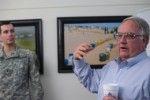From a blood diamond conflict in Sierra Leone to the Mount Hagen Festival in Papua New Guinea, Howard G. Buffett has captured stories from across the globe. Already given the opportunity to interact with his photography, students were able to hear these accounts when Buffett spoke on campus Tuesday.
Buffett discussed the inspiration and motivation behind his photos, which are on display on the fourth floor of the Agriculture and Life Sciences Building. Students enrolled in a Methods of Environmental Interpretation course will use the stories behind Buffett’s photos to create interpretive webpages for each photo.
Buffett said he got his start in photojournalism after borrowing his daughter’s camera, and his newfound hobby soon developed into a love of photography.
“I used to borrow her camera all the time,” Buffett said. “My wife finally bought me a camera. I just started taking pictures on the farm. Then I got interested in wildlife and that’s when I started to buy better cameras. I worked into it.”
Depicting scenes of conflict and wildlife, Buffett said his photography reflects his interests in conflict and conservation. Describing his interest in the connection between poverty, wildlife and conflict as one of necessity, Buffett said people rarely try to solve problems by addressing all aspects of the issue.
“You find out that people won’t try certain things in conflict areas,” Buffett said. “For us, it became an area where there was a lack of resources and a lack of interest. Someone said to me, ‘You have to separate hunger from conflict,’ and it just blew me away. You can’t, but people want to because it’s messy. And hard.”
In addition to their beauty, Edwin Price, the Howard G. Buffett Chair on Conflict and Development, said Buffett’s photographs provide an excellent educational resource for students.
“They are an excellent tool for training students in how to interpret works of art or nature for others to understand,” Price said. “For those that are involved in parks, recreation and nature, it gives us an opportunity to see that nature and environment are very vulnerable to people’s need to survive, and we see poverty and conflict as a threat to this natural wildlife.”
Buffett also sat down to talk with the recipients of the Student Media Grants Program, an endowment funded by the Howard G. Buffett Foundation that enables students to chronicle and research issues in conflicted nations around the world.
2013 SMGP awardee Michael Petriello was present to discuss his upcoming project, which will research the connection between conflict and ecological knowledge and its transmission through generations.
“The main mechanism for that will be using disposable cameras and interviewing people and just focus on the story behind how existing conflict is affecting how people interact with the ecosystem,” Petriello said.
Buffett’s photography is an extremely powerful way of communicating both the emotion and reality of conflicted nations, Petriello said, as well as beauty in natural life.
“I think his photos really captured the different elements of the human end of ecological conditions that are pretty important to ecological issues,” Petriello said. “Some of the photos were focused on animals that really define what conservation is and are really important to parks and protection issues. In that sense, he’s not only capturing the ecological side, but the biological side of political issues like food security.”
Conflict, conservation mesh in photographer’s work
March 25, 2014

0
Donate to The Battalion
Your donation will support the student journalists of Texas A&M University - College Station. Your contribution will allow us to purchase equipment and cover our annual website hosting costs.
More to Discover








